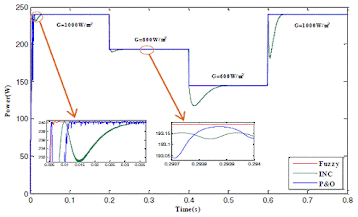ABSTRACT:
In
this work, a novel technique based on second order sequence filter and
proportional resonant controller is pro- posed for control of universal active
power filter integrated with PV array system (UAPF-PV). Using a second order
sequence filter and sampling it at zero crossing of instant of the load
voltage, the active component of distorted load current is estimated which is
further used to generate reference signal for shunt active filter. The proposed
method has good accuracy in extracting fundamental active component of
distorted and unbalanced load currents with reduced mathematical computations.
Along with power quality improvement, the system also generates clean energy
through the PV array system integrated to its DC-bus. The UAPF-PV system
integrates benefits of power quality improvement and distributed generation.
The system performance is experimentally evaluated on an experimental prototype
in the laboratory under a variety of disturbance conditions such as PCC voltage
fall/rise, load unbalancing and variation in solar irradiation.
KEYWORDS:
1. Power
quality
2. Universal
active power filter
3. Adaptive
filtering
4. Photovoltaic
system
5. Maximum
power point tracking
6. Sequence filter
SOFTWARE: MATLAB/SIMULINK
BLOCK DIAGRAM:
Fig. 1. System configuration of UAPF-PV
(a) Performance under Load Removal
(b) Performance under Load Addition
Fig.
2. Dynamic Performance under load Unbalance Condition
(b) Performance under Swell Condition
Fig.
3. Dynamic Performance under PCC Voltage dip/rise Condition
Fig. 4. UAPF-PV Response under irradiation Change Condition
Fig. 6. Salient Signals in Extraction of Fundamental Positive Sequence Load Current
(a) Salient Signals in Shunt Active Filter Control
(b)
Salient Signals in series active filter Control
Fig.
7. Salient Signals in UAPF-PV Control
The performance of a novel control technique for solar PV system with universal active filtering has been evaluated. The fundamental positive sequence component of nonlinear load current is extracted using a second order sequence filter along with a zero cross detection technique. The series active filter is controlled using a proportional resonant controller implemented in _ − _ domain along with feedforward component. The system performs satisfactorily under disturbances such as PCC voltage dip/rise, changes in solar radiation and load disturbances. Apart from improving power quality, the system also supplies power from PV array into grid. A comparison of the proposed control shows that the system has improved performance as compared to conventional control techniques with slightly lower computational burden. The system integrates distributed generation along with enhancing power quality of distribution system.
REFERENCES:
[1]
S. J. Pinto, G. Panda, and R. Peesapati, “An implementation of hybrid control
strategy for distributed generation system interface using xilinx system
generator,” IEEE Transactions on Industrial Informatics, vol. 13, no. 5,
pp. 2735–2745, Oct 2017.
[2]
B. Singh, A. Chandra, K. A. Haddad, Power Quality: Problems and Mitigation
Techniques. London: Wiley, 2015.
[3]
B. Singh, M. Kandpal, and I. Hussain, “Control of grid tied smart pvdstatcom system
using an adaptive technique,” IEEE Transactions on Smart Grid, vol. PP,
no. 99, pp. 1–1, 2017.
[4]
Y. Singh, I. Hussain, S. Mishra, and B. Singh, “Adaptive neuron detection-based
control of single-phase spv grid integrated system with active filtering,” IET
Power Electronics, vol. 10, no. 6, pp. 657–666, 2016.
[5]
C. Jain and B. Singh, “An adjustable dc link voltage-based control of
multifunctional grid interfaced solar pv system,” IEEE Journal of Emerging
and Selected Topics in Power Electronics, vol. 5, no. 2, pp. 651–660, June
2017.

































